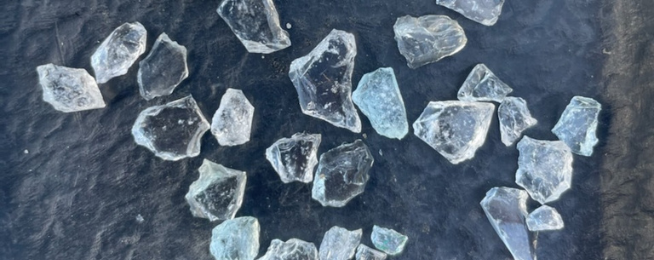Sharp glass particles have been discovered in the bike lanes along Beach Road where numerous riders suffered punctures on the weekend.
Investigations today have found that the broken glass has been scattered on recently installed green bike lane treatments in Elwood, which contain recycled glass.
The sharp particles were hidden among the freshly applied green bike lane treatment that is comprised of polished glass beads and other materials.
As a result, many riders believed that it was the typical bike lane glass that had punctured their tyres.
An investigation by the Department of Transport (DoT) has found the foreign glass particles scattered onto the green bike lane treatments at several intersections.
DoT says it will work with Victoria Police to determine if the act was vandalism.
DoT and its contractors removed loose glass from the sites this morning and discovered numerous shards that were not part of the bike lane treatment.
The glass used in bike lanes has been polished to remove sharp edges and coated with a green tint on all sides and has been used in Melbourne for 10 years without concern. The same material has been used for 20 years in Australia for line marking and other skid resistance purposes, again without problems.
Bicycle Network Acting Chief Executive Officer, Bec Lane, said today that a bike tyre puncture was more than a simple inconvenience: it could put the lives and welfare of riders at risk.
“A puncture can cause a bike to become unstable and a rider to fall, with potential for injury or worse if other traffic is about,” she said.
“Huge numbers of Melburnians use bikes for transport and recreation every day, and are healthier and happier for it.
“The roads are for everyone and we all have a responsibility to keep them safe for each other."
DoT said today: "While our green treatments do make use of recycled glass, the glass found on Beach Road is inconsistent in shape, size and colour with the beads used in our green asphalt.
"We use green surface treatment in areas of potential conflict to increase the visibility of the bike lanes and reinforce the presence of bikes in that area.
"The green material is a compound that is skid-resistant, hard wearing and often has a high content of recycled glass and rubber.
"It is not an abrasive or sharp material and can be comfortably touched and handled.
"The aggregate material, in conjunction with a binding agent, has been used for many years as a specified solution for cycle lanes to maintain a level of skid resistance value and ensure cyclists are not slipping."
Become our friend
Find out more about Bicycle Network and support us in making it easier for people to ride bikes.


